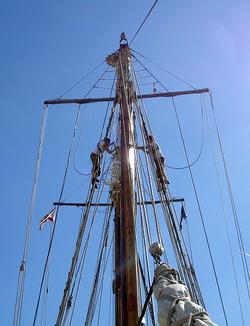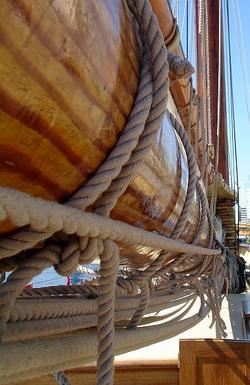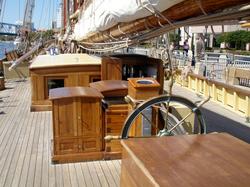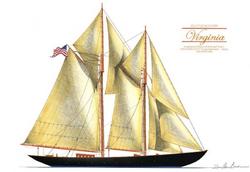
Schooner Virginia
Going out in all sorts of weather and sea conditions is the job of the harbor pilot. To do this they must be competent mariners and know not only how to steer their own vessels but any that they may have to bring in to port. In 1915 the Virginia Pilot Association’s president, William Rowe Boutwell ordered a schooner built to keep his pilots “sharp sailors” It was launched in 1917 as the schooner Virginia. Although most pilots at this point were operating steam vessels, such as the V.P.A.’s steamer Relief, to be able to weather more adverse conditions Boutwell’s ship ensured the best skills among his men as well as keeping a proud history alive. Keeping that story today is the schooner Virginia. She is a replica of William Boutwell’s boat, also named the Virginia, and recently came to visit us here on the First Coast.
(Be sure to click on photos to englarge them.)

Schooner Virginia tied up along Jacksonville’s waterfront. Note the this knockabout’s distinctive bow overhang.
Framed from laminated white oak and planked with a type of South American juniper, the Virginia’s hull is 114’ on deck and 84’ at the waterline with a 24’ beam. She’s single planked up to the waterline and double planked above, fastened with copper. While the original 1917 schooner wouldn’t have employed laminated oak or exotic juniper building a modern replica out of wood and maintaining 100% authenticity is tough to do. Finding large amounts of oak and local juniper makes building out of historic materials implausible due to cost and availability. But, unlike her predecessor ,the replica Virginia was built in the Commonwealth of Virginia. Boutwell’s 1917 boat was built in Staten Island, New York by A.C. Brown & Son!

Stern view.

The original schooner Virginia under sail.
Headed to Miami to pick up a group of students for an eco-cruise, the Virginia stopped in Jacksonville to tie up along the riverfront near the Landing. I had called her captain, Hank Moseley, to arrange an interview and visit and so last Friday we met onboard. Cpt. Moseley was most gracious with this interview since the entire crew was busily performing heavy maintenance to the rigging and brightwork. Virginia’s brightwork consists of all the wood that is not painted. Her deck housing, gunnels, steering station, masts, booms, gaffs, and many other wooden items were all treated to keep them shiny and looking new. This job is an ongoing one that takes a good captain and crew just to keep up with.

Crewmembers in the rigging preparing the foretopmast for striking it to deck.
The topmasts had been lowered to deck for re-varnishing and inspection. This is no small feat and is a delicate operation. Ship’s masts are seldom made from one stick of wood. A large trunk or laminate is generally used to form the mainmast which originates on the keel of the vessel at what is called the ‘step’. From there it juts skyward, up through the decks, eventually reaching high above the weather deck and ends at what is called the masthead. A masthead is a junction where the next section of the mast is joined through a series of iron collars, wooden wedges, and lashings. Virginia is schooner rigged, carrying two masts and each mast has a topmast attached to the mastheads. So, at each masthead the topmast protrudes to give the mast its full height. For this boat, she stands 121’ above the waterline, a considerable length of wood to carry her 6,538 square feet of sail. The term schooner rigged implies that the mainmast is either taller than or equal in height to any foremasts and that the masts have some amount of ‘rake’ to them, the swept back look that gives schooners their sleek looks. She carries no square sails such as one would see on a brig rigged ship or topsail schooner rigged with yards. However, when carrying a full press of sail (every sail set) there are no fewer than eight sails.

View from the bow looking aft along her decks. Everything that is out of place is out of place for a reason due to the major work going on. Still, pretty clean for a working ship.
To manage all of these sails the boat requires miles of line and a competent crew who knows what each line means. Like any tallship the rig can be intimidating for the flatlander first stepping aboard. But, if you follow each line you can see how they perform a specific task, ultimately causing the whole mechanism to work in symphonic harmony required by the skipper. Gantlines, or working halliards, are used to perform sundry lifting tasks within the rig and during my visit the crew was busily rigging gantlines to the foretopmast to handle swaying it down to deck. While I was busy being a tourist/interviewer Cpt. Moseley called for all hands to help lower the foretopmast and even I wasn’t exempt from duty. Dylan Clark, part of the Virginia’s crew, and I were on a tag line which helped to kick the foot of the foretopmast out as it came down from a vertical position to make sure it ended up in a horizontal position. This stage is somewhat tricky since a slip of this big stick of wood could send it plunging through the decks and even through the hull! Once the mast was struck to the deck, we bear-hugged it to move it aft a bit for more sure footing. I missed seeing the topmasts sent back up into the rigging but that must be even more thrilling of an endeavor to get those big sticks back up so high and firm enough to take the strain of the stays.

The maintop struck. One coat of varnish has been applied and it is waiting for a second. Hell of a toothpick!
The modern Virginia differs a little from her original counterpart. For one, she’s a little longer to account for two 205hp Caterpillar powerplants. In her engineering space a Northern Lights generator supplies power to the galley, lighting, instrumentation, and an electric windlass carried forward of the foremast. To pack this in Tricoastal Marine, her design team, added ten feet to the hull length. Since the Coast Guard has taken a more proactive role in ensuring the safety of modern vessels the hull must be able to pass a theoretical stability test. The test is a mathematical problem that takes into account the rig height, sail plan, the turn of the bilge, draft, and ballast to make sure that the ship won’t capsize too easily. Virginia’s engineers added a foot of draft to comply with these standards. The visitor is hard pressed to notice too many modern amenities on deck despite these changes. Aside from required safety gear like life rafts, fire extinguishers, and the electronic windlass Virginia’s deck is surprisingly well organized. The clean lines of a schooner help account for this since no spars have to be tended for square sails and the shrouds aren’t contaminated with the normal melee of ratlines seen onboard a square rigger.

The main boom.

Looking forward along the fore boom. What a beautiful bunch of canvas, wood, and lines.
What I found to be very interesting on deck was a device called a ‘gyber’. Made of heavy bronze castings and thick rubber disks the mechanism takes the shock load of a swinging boom and applies it to the deck while absorbing much of the shock. When a sailing vessel ‘gybes’ or ‘jibes’ she is running before the wind and turns from one angle to another, maintaining her downwind run. Thus, instead of the sails gently easing from port to starboard, or vice versa, they come about quickly, snatched by the wind and swung violently to the leeward side. Continual gibing leads to accelerated wear on the rig as well as the points of attachment.

The gyber. Each boom has one.
This Chesapeake Bay pilot schooner differs from many of her earlier sisters in that her design was inspired by America’s Cup defenders and she once managed to sail a hair over fifteen miles in one hour, not too bad for a 118’ vessel. In 1919 a diesel engine was added since inbound vessels were less patient than in the past to wait for a pilot boat to get a fair breeze for sailing. She was also used heavily as a party boat to entertain political friends of the Virginia Pilots Association. Newspapers of the period hacked away at the Virginia, calling her events frivolous and extravagant. In retrospect, many of her functions were for the pilots association to court politicians since then Governor Davis was hacking away at the pilots’ wages. She managed to weather all of this and was known throughout the region as an able and quick sailor.

Virginia‘s steering station. Note the majestic woodwork and elegant bronze wheel.
One immediately noticeable difference is her lack of a bowsprit. Known as a ‘knockabout’ style of gaff-rigged schooner (the gaffs are the large horizontal poles holding up the tops of the mainsail and foresail), there are two reasons for this. For one, when approaching a wharf or pier there is less of a ‘bayonet’ to stick out and foul in other ship’s rigging. Secondly, not having a bowsprit makes a boat much safer in one major way. None of her crew have to go out on a bowsprit or ‘into the chains’ to un-gasket a jib or spritsail. To account for the lack of this balancing pole, she carries more bow overhang than other schooner types. This style was popularized by Grand Banks dory fishing schooners during the early 20th century and some of the most famous New England windjammers were knockabout built. So, don’t let the name fool you, she’s all business.
One of the most famous stories of the original Virginia was of a bridge that, when opened for boats, was too narrow for the big schooner to slip though when heeled over under sail. Her pilot, ‘ScobieVirginia’ Guy, spilled her wind at just the right time with enough momentum for Virginia to stand back up, allowing her masts to become vertical once more and clear the bridge. Once clear, he hauled the sheets and put the wind back in the sails!
The original Virginia’s history as a working schooner comes to an end during the 1930s when she was sold off to a private individual to be used as a pleasure yacht and for racing. We don’t know where but records indicate that in 1947 the Virginia was listed as ‘stranded’. The new Virginia revives her predecessor’s prowess and adds a new facet. Acting as the official vessel for the Commonwealth of Virginia she is a school ship for young mariners seeking experience at sea. Each year thousands of schoolchildren go aboard for tours or daysails to experience the thrill and splendor of a wooden sailing ship. She is by no means tied up to dock and few barnacles grow on the planking. An active sailing schedule is maintained that involves races up and down the Chesapeake Bay, the Gloucester Schooner Festival, Tallships 2009, the Charleston to Bermuda Race, and other itinerant billets up and down the Atlantic coast. On almost every one of these voyages she carries paying customers who get to experience life on the blue water and arrive at their destinations with a small carbon footprint and big smile.

The chartroom. Well organized and roomy.
Virginia’s homeport is Norfolk, Virginia where she was built along the banks of the Elizabeth River. To get on decks for a tour, check the association’s webpage for their upcoming cruising schedule. Just about every port she visits at least one day is spent opening the ship to the public. I want to personally thank Cpt. Hank Moseley and his great crew for allowing me to come aboard, showing me around, letting me help out, and even feeding me! I also have the honor to announce that Cpt. Moseley invited me to help crew the boat from Jacksonville to Miami. This weekend I will stow my gear belowdecks, get training from the crew, and then we set sail for a 3-4 day transit to Miami. For a person whose never visited Miami what a heck of a way to arrive! So, stay tuned for more to come regarding the schooner Virginia and I’ll see you when I return.

The Tricoastal Marine artists rendition of the boat as it was being built. Note there are eight sails in this rendition. The Virginia only carries an aft fisherman, a type of sail that fills in between the gaff and topmast.

The galley, where Carey performs her magic. I was told she will also answer to the moniker ‘Mother Theresa’.

A spacious salon where crew meals are served, note the bunks in the background. This is where I’ll be berthed while onboard. (Image courtesy of the V.M.H.A.)

The ship’s bell.

Virginia‘s able crew, minus a couple on shore leave. From left to right: Jaime Larzelere, Aaron Sanders, Dylan Clark, Sara Cole (1st Mate), Hank Moseley (Captain), and the talented cook Carey Dreager (enjoy her blogs on the schooner’s website) Thank you guys for the hospitality and friendship aboard!

Cpt. Moseley, Virginia, and me. Three proud Virginians!

